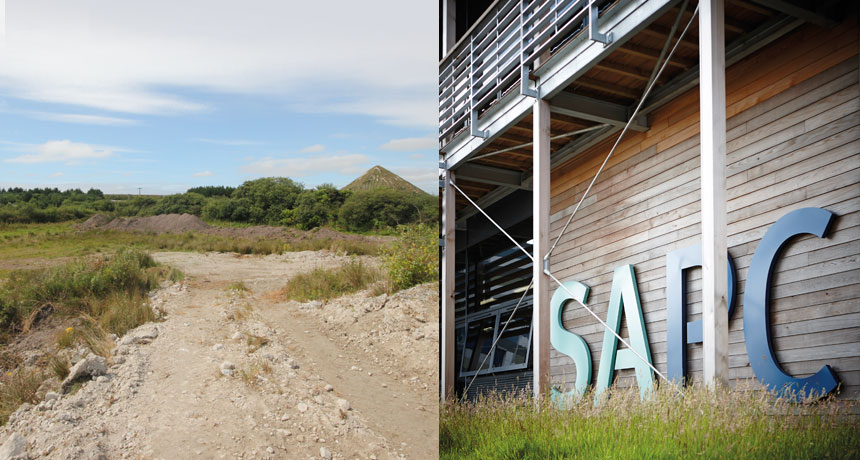How SAPC transformed wasteland to flourishing gardens

Since 2013, on one of the main routes into St Austell, people have been welcomed to the town by the iconic St Austell Printing Company Factory, which stands proudly overlooking the bay.
Although the factory is a familiar sight, as people drive past they will not always appreciate the story behind the flourishing grounds in which it sits.
St Austell Printing Company (SAPC) is widely acknowledged as one of Cornwall’s sustainability leaders. The family-run company moved from their town centre location, their home since 1981, to a brand new sustainable factory which was rated excellent by BREEAM, the world’s leading sustainability assessment for buildings.
Featuring it’s own solar panel array, rainwater harvesting and natural ventilation it’s one of Cornwall’s most sustainable factories and was developed alongside a brand new Business Park and Conference Centre.
SAPC’s ongoing commitment to the environment meant they were recognised as one of the area’s most sustainable businesses at last year’s Cornwall Sustainability Awards.
When it was looking for a new home, SAPC chose to develop a site full of slag (waste) from the adjacent disused Old Baal China Clay Pit. After the pit closed in the 60s, for nearly forty years the future SAPC site was brownfield, becoming a marshland where nothing grew.
Amanda Moody, SAPC Director and environmental champion explains the vision: ”When we developed the site, we didn’t want to just construct a building and car park. We wanted to create a space that our staff, visitors and tenants wanted to come to as well as create an environment in which the wildlife could thrive.
“It’s important that we created a work environment that everyone would be proud of. We also wanted to reflect the unique eco-system and nature that surrounds our business park.”
With poor, clay-based stoney soil and an exposed location it was always going to be a challenge to select the right plants. SAPC worked with Imerys to identify appropriate additions and all the plants on site are indigenous to the surrounding clay pit areas.
“Some of these plants aren’t particularly noteworthy, but they were chosen as they could survive and thrive in the winds and harsh elements our exposed location sometimes has to endure.” Amanda continued.
Plants and flowers include Iris, Forget Me Nots, Geraniums, Grasses, Oxide Daisies, Ragged Robin and Sea Buckthorne. Some of the native trees on site include Hawthorns and Sorbus. SAPC planted natural hedges to surround the site and wildflowers are allowed to germinate and spread naturally.
“It was important to us that all of the plants we chose were bee and butterfly friendly. Encouraging more insects to the site attracts more wildlife such as birds. By choosing the plants carefully, we’ve endeavoured to create a self-sustaining eco-system that’s teeming with wildlife.”
To that end, SAPC proudly declare that they don’t use any chemicals on site and all the gardens are hand-weeded
“We regularly see deer, rabbits, frogs, butterflies and dragonflies. We even have a couple of Kestrels who come and perch themselves on our balconies, the perfect vantage point for spotting their dinner. We feel proud to have create an environment for these animals to enjoy.”
It hasn’t all been plain sailing. A grass bank on the east of the site proved too exposed for the original choice of plants. “The French Lavender and grasses didn’t grow as expected, neither did the trees. However, there are examples of the same plants thriving in other areas of the site.
“We also spread one million poppy seeds in the hope they would create a beautiful wildflower meadow. Unfortunately the winds had their way and a single poppy survived.”
As part of the ecology plans for the business park, a wildlife pond was constructed to the side of the main building to provide opportunities for other wildlife to find a home.
“We have as little intervention as possible because we want the wildlife in the pond to develop naturally. This is with the exception of an annual inspection where we remove some of the weeds which are strangling the vegetation. But we will only perform this at time in which breeding doesn’t occur.”
There’s no fish in the pond, but it provides a home for thousands of invertebrates, dragonflies, damson flies, water boatmen, newts, tadpoles and of course frogs. “The great thing about having frogs on site is that we never have any issues with slugs!” Amanda laughed.
As well as being a favourite spot for SAPC staff, tenants from the business park also regularly use the pond and outside space for breaks and meetings. During the summer it’s not usual for events from the Conference Centre to move outside and enjoy the sunshine.
“Our staff enjoy the outdoor space and we feel it’s important to give them the opportunity to get away from the demands that working for a busy company bring.” Amanda added.
“We could have saved a lot of money and effort developing a business park which consisted of just car parks and buildings. But with such beautiful surroundings we felt it was an obligation to create an environment to enable nature to flourish.”
Amanda concluded: “Not only do we feel this is a gift to nature, but also our staff and local community – enabling people to enjoy what was wasteland until very recently.”
The gardens were the vision of MeiLoci, who oversaw the design and implementation of the gardens to ensure our business park stand out from any other. Find out more here.
SAPC also works closely with Darren Hawkes Landscapes. Find out more here.